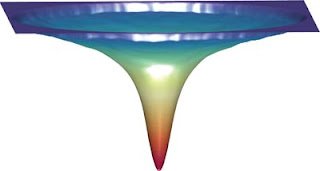 |
| Physics World - a 'solar energy funnel' |
Computer simulations by researchers in the US and China could lead to solar cells that work efficiently across a broad range of the solar spectrum. Dubbed a "solar energy funnel", the new concept offers a way of using strain to modify the band gap of a semiconductor so that it responds to light within a range of different wavelengths. However, the funnels have yet to be made and tested in the lab – some researchers suggest using them in practical devices could prove problematic.
The basic operating principle of a solar cell is that an electron in the valence band of a semiconductor material absorbs a photon and jumps across an energy "band gap" into the conduction band. The result is an electron and a positively charged hole, which do not move separately through the semiconductor but instead form a bound state called an exciton. To extract electrical energy, the electron is collected at one electrode and the hole at another.
Light from the Sun comes in a range of wavelengths and therefore an ideal solar cell should be very efficient at converting this broad spectrum into electricity. Unfortunately, semiconductors with a fixed band gap are not very good at doing this. In particular, longer-wavelength photons do not have enough energy to make an electron to jump the band gap and will not be converted into electrical energy. Photons with energies greater than the band gap will be converted, but regardless of their energy they will only create just one electron–hole pair. Any excess energy will be dissipated in the semiconductor as heat.
Physics World: Semiconductor funnel could boost solar cells
Comments